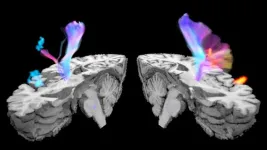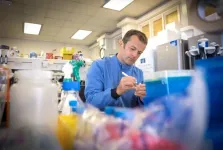(Press-News.org) Researchers have created a “metal detector” algorithm called PRRDetect to hunt down vulnerable tumours, in a development that could one day revolutionise the treatment of cancer.
In a paper published today (Thursday 10th April) in Nature Genetics, scientists funded by Cancer Research UK and the National Institute for Health and Care Research (NIHR) analysed the full DNA sequence of 4,775 tumours from seven types of cancer. Based at the University of Cambridge and NIHR Cambridge Biomedical Research Centre, they used that data from Genomics England’s 100,000 Genomes Project to create an algorithm capable of identifying tumours with faults in their DNA that make them easier to treat.
The algorithm could one day help doctors figure out which patients are more likely to have successful treatment. That could pave the way for more personalised treatment plans that increase people’s chances of survival.
Professor of Genomic Medicine and Bioinformatics at the University of Cambridge, NIHR Research Professor and lead author of the study, Professor Serena Nik-Zainal, said:
“Genomic sequencing is now far faster and cheaper than ever before. We are getting closer to the point where getting your tumour sequenced will be as routine as a scan or blood test.
“To use genomics most effectively in the clinic, we need tools which give us meaningful information about how a person’s tumour might respond to treatment. This is especially important in cancers where survival is poorer, like lung cancer and brain tumours.
“Cancers with faulty DNA repair are more likely to be treated successfully. PRRDetect helps us better identify those cancers and, as we sequence more and more cancers routinely in the clinic, it could ultimately help doctors better tailor treatments to individual patients.”
The research team looked for patterns in DNA created by so-called “indel” mutations, in which letters are inserted or deleted from the normal DNA sequence.
They found unusual patterns of “indel” mutations in cancers which had faulty DNA repair mechanisms – known as “post-replicative repair dysfunction” or PRRd. Using this information, the scientists developed an algorithm called PRRDetect which allows them to identify tumours that have PRRd from a full DNA sequence.
PRRd tumours are more sensitive to immunotherapy, a type of cancer treatment that uses the body’s own immune system to attack cancer cells. The scientists hope that the PRRd algorithm could act like a “metal detector” to allow them to identify patients who are more likely to have successful treatment with immunotherapy.
The study follows from a previous “archaeological dig” of cancer genomes carried out by Professor Serena Nik-Zainal and funded by Cancer Research UK. This “dig” examined the genomes of tens of thousands of people and revealed previously unseen patterns of mutations which are linked to cancer. This time, Professor Nik-Zainal and her team looked at cancers which have a higher proportion of tumours with PRRd. These include bowel, brain, endometrial, skin, lung, bladder and stomach cancers. Whole genome sequences of these cancers were provided by the 100,000 Genomes Project - a pioneering study led by Genomics England and NHS England which sequenced 100,000 genomes from around 85,000 NHS patients affected by rare diseases or cancer.
The study identified 37 different patterns of indel mutations across the seven cancer types included in this study. Ten of these patterns were already linked to known causes of cancer, such as smoking and exposure to UV light. Eight of these patterns were linked to PRRd. The remaining 19 patterns were new and could be linked to causes of cancer that are not fully understood yet or mechanisms within cells that can go wrong when a cell becomes cancerous.
Executive Director of Research and Innovation at Cancer Research UK, Dr Iain Foulkes, said:
“Genomic medicine will revolutionise how we approach cancer treatment. We can now get full readouts of tumour DNA much more easily, and with that comes a wealth of information about how an individual’s cancer can start, grow and spread.
“Tools like PRRDetect are going to make personalised treatment for cancer a reality for many more patients in the future. Personalising treatment is much more likely to be successful, ensuring more people can live longer, better lives free from the fear of cancer.”
NIHR Scientific Director, Professor Mike Lewis, said:
“Cancer is a leading cause of death in the UK so it's impressive to see our research lead to the creation of a tool to determine which therapy will lead to a higher likelihood of successful cancer treatment.
"The NIHR is at the forefront of developing cancer treatments as we aim to meet the Secretary of State’s goal of reducing the UK’s major killers. This is yet another example of how we can work together with partners like Cancer Research UK and lead research that improves people's health outcomes, allows them to live longer and live better."
Chief Scientific Officer at Genomics England, Professor Matt Brown, said:
“Genomics is playing an increasingly important role in healthcare and these findings show how genomic data can be used to drive more predictive, preventative care leading to better outcomes for patients with cancer.
“The creation of this algorithm showcases the immense value of whole genome sequencing not only in research but also in the clinic across multiple diverse cancer types in advancing cancer care.”
The paper, titled “Redefined indel taxonomy reveals insights into mutational signatures”, was published today (Thursday April 10th) in Nature Genetics*.
ENDS
For media enquiries, contact Graeme Sneddon in the Cancer Research UK press office on 07827936507 or, out of hours, on 020 3469 8301.
Notes to Editor
* The paper will be available from https://www.nature.com/articles/s41588-025-02152-y when the embargo lifts.
About Cancer Research UK:
1. Cancer Research UK is the world’s leading cancer charity dedicated to saving lives through research, influence and information.
2. Cancer Research UK’s pioneering work into the prevention, diagnosis and treatment of cancer has helped save millions of lives.
3. Cancer Research UK has been at the heart of the progress that has already seen survival in the UK double in the last 50 years.
4. Today, 2 in 4 people survive their cancer for at least 10 years. Cancer Research UK wants to accelerate progress and see 3 in 4 people surviving their cancer by 2034.
5. Cancer Research UK supports research into the prevention and treatment of cancer through the work of over 4,000 scientists, doctors and nurses.
6. Together with its partners and supporters, Cancer Research UK is working towards a world where people can live longer, better lives, free from the fear of cancer.
For further information about Cancer Research UK's work or to find out how to support the charity, please call 0300 123 1022 or visit www.cancerresearchuk.org. Follow us on Twitter and Facebook
About the National Institute for Health and Care Research
The mission of the National Institute for Health and Care Research (NIHR) is to improve the health and wealth of the nation through research.
We do this by:
funding high quality, timely research that benefits the NHS, public health and social care
investing in world-class expertise, facilities and a skilled delivery workforce to translate discoveries into improved treatments and services
partnering with patients, service users, carers and communities, improving the relevance, quality and impact of our research
attracting, training and supporting the best researchers to tackle complex health and social care challenges
collaborating with other public funders, charities and industry to help shape a cohesive and globally competitive research system
funding applied global health research and training to meet the needs of the poorest people in low and middle income countries
NIHR is funded by the Department of Health and Social Care.
Our work in low and middle income countries is principally funded through UK international development funding from the UK government.
END
Scientists create “metal detector” to hunt down tumors
2025-04-10
ELSE PRESS RELEASES FROM THIS DATE:
New USC study identifies key brain networks behind post-stroke urinary incontinence
2025-04-10
A new USC-led study using functional magnetic resonance imaging (fMRI) reveals the neural mechanisms that contribute to urinary incontinence, a common condition affecting stroke survivors that has a significant impact on their quality of life.
The research, just published in Stroke, was conducted by a multidisciplinary team of urologists, neurosurgeons, and imaging experts from the Keck School of Medicine of USC, Keck Medicine of USC, the Rancho Los Amigos National Rehabilitation Center, and the Shirley Ryan Ability Lab. The team discovered significant differences in brain activity during voluntary versus involuntary bladder contractions, presenting potential pathways for targeted therapies.
Urinary ...
Hidden potential in multiple disabilities
2025-04-10
Using eye-tracking — a technique for recording and analysing eye movements — a team from the University of Geneva (UNIGE) has shown that individuals with multiple disabilities can improve their social and emotional skills. Although these patients are often considered ‘‘untestable’’, nine young people have undergone personalised training over a period of one year, with promising results in terms of their ability to socialise. This work opens the way to new methods of assessment and support. It is published in Acta Psychologica.
Multiple disabilities involve a combination of severe intellectual and motor impairments, resulting in profound dependence. ...
How to protect bumblebee colonies safe from killer moths? Keep honeybee hives away from them
2025-04-10
Since the pandemic, we are very aware of the power of social distancing to protect against infectious disease. But can social distancing be effective if the infectious agent isn’t a virus or bacterium, but an insect powered by a brain and wings, and with the instinct to seek out new hosts?
Now, a study published to Frontiers in Bee Science has shown that physical distance does play a leading role in protecting bumblebees against a flying insect parasite, the bumblebee wax moth Aphomia sociella. The source of the potentially lethal infection was another species, namely nearby hives of domestic honeybees.
“Here we show that infestation with bumblebee wax moths is much greater ...
Rolling particles make suspensions more fluid
2025-04-10
Lacquers, paint, concrete—and even ketchup or orange juice: Suspensions are widespread in industry and everyday life. By a suspension, materials scientists mean a liquid in which tiny, insoluble solid particles are evenly distributed. If the concentration of particles in such a mixture is very high, phenomena can be observed that contradict our everyday understanding of a liquid. For example, these so-called non-Newtonian fluids suddenly become more viscous when a strong force acts upon them. For a brief moment, the liquid behaves like a solid.
This sudden thickening is caused by the particles present ...
Research fine tunes tools used to search for genetic causes of asthma
2025-04-10
Genome wide association studies (GWAS) have identified hundreds of genome regions containing thousands of genetic variants associated with asthma, but it’s still not clear which variants have an actual causal link to the disease. This “variant-to-function” gap is one of the biggest challenges to the usefulness of these genomic studies and has motivated researchers to develop new tools to make sense of GWAS results.
A new study by researchers from the University of Chicago combines genetic data and improved computational tools to look more closely ...
Meditation and critical thinking are the ‘key to meaningful AI use’
2025-04-10
People should learn to meditate and hone their critical thinking skills as AI becomes more integrated into daily lives, an expert suggests.
Digital strategy expert Giulio Toscani has spoken with 150 AI experts across 50 countries to understand the challenges and opportunities around human interactions with artificial intelligence.
He argues in his new book, Augmented: prAIority to Enhance Human Judgment through Data and AI, that as humans operate largely unconsciously by design, they are inclined toward immediacy and instant rewards, often overlooking potential ...
Studies shows new class of antibiotic is effective in tackling MRSA
2025-04-10
The development of new antibiotics to treat superbugs and other bacterial infections is a global priority, with the rate of infections that cannot be treated with current antibiotics rising and presenting one of the biggest threats to human health.
In line with that, new research has shown a daily dose of epidermicin NI01 – an antibiotic compound developed by University of Plymouth spinout company Amprologix – is as effective at removing Methicillin-resistant Staphylococcus aureus (MRSA) as the current standard of care.
The results were achieved through a robust skin MRSA infection model, and those behind the research say it justifies ...
Certain nasal bacteria may boost the risk for COVID-19 infection, study finds
2025-04-10
WASHINGTON (April 9, 2025) — A new study from researchers at the George Washington University has found that certain bacteria living in the nose may influence how likely someone is to get a COVID-19 infection. Published in EBioMedicine, the research reveals that certain types of nasal bacteria can affect the levels of key proteins the virus needs to enter human cells, offering new insight into why some people are more vulnerable to COVID-19 than others.
“We’ve known that the virus SARS-CoV-2 enters the body through the respiratory tract, with the nose being a key entry point. What’s new—and surprising—is that bacteria in our noses ...
Europe's population is adapting better to cold than to heat
2025-04-09
A study led by the Barcelona Institute for Global Health (ISGlobal), a centre supported by the "la Caixa" Foundation, has shown that Europe has adapted better to low temperatures than to high temperatures over the last two decades. The research, carried out in collaboration with the Barcelona Supercomputing Centre (BSC) and published in The Lancet Planetary Health, shows that there has been a significant decrease in cold-related mortality risk in recent years compared to the first decade of the 2000s. There has also been a reduction in the risk of heat-related ...
Ancient tools from a South African cave reveal connections between prehistoric people
2025-04-09
In a cave overlooking the ocean on the southern coast of South Africa, archaeologists discovered thousands of stone tools, created by ancient humans roughly 20,000 years ago. By examining tiny details in the chipped edges of the blades and stones, archaeologists are able to tell how the tools were made. In a new study published in the Journal of Paleolithic Archaeology, researchers analyzed these stone tools and discussed how the different techniques used to make them hint at the ways that prehistoric people traveled, interacted, and shared their craft.
“This is an important insight into how people who lived in this region ...




